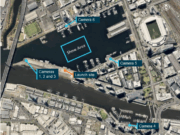Demonstration flights at three separate test sites have shown that simultaneous beyond visual line-of-sight (BVLOS) drone operations can be safely conducted at low altitudes in areas where U.S. Federal Aviation Administration (FAA) air traffic services are not provided, the FAA says.
The demonstration flights were part of an effort by the FAA, the U.S. National Aeronautics and Space Administration and partner organizations to pave the way for a drone traffic management system, the FAA said.
The most recent of the three demonstrations, which involved the Nevada Institute for Autonomous Systems, took place Aug. 1 in Las Vegas. Operators of participating flights by drones — also known as unmanned aircraft systems (UAS), unmanned aerial vehicles and by other names — surveyed a golf course, obtained video of a property being sold and scanned a lake for boating opportunities, the FAA said Wednesday.
The three operators accessed maps specifically for unmanned aircraft and obtained proper approvals for their flights, the FAA said, adding that, during the course of the flights, a fire broke out at the golf course. A fire-fighting helicopter was dispatched, and its crew requested issuance of a UAS volume reservation (UVR) to notify drone operators in the area of the emergency. The drone operators either landed or continued operations at a safe distance from the fire, the FAA said.
Another demonstrations, conducted July 10 in Grand Forks, North Dakota, involved the Northern Plains UAS Test Site. Participants photographed firefighter training, scanned the University of North Dakota to identify a tailgating location and evaluated power line damage after previous strong winds. During their flights, a UVR was issued, warning of an emergency medical services helicopter in the area. The drone on the photography flight landed, and the other flights continued, away from the helicopter’s flight path, the FAA said.
The earliest of the three demonstrations, conducted June 13 by the Virginia Tech Mid-Atlantic Aviation Partnership at Virginia Tech in Blacksburg, Virginia, involved drones delivering packages, studying wildlife, surveying a cornfield and reporting on a court case. While the demonstration was in progress, an emergency helicopter was required to transport a patient to a hospital, and the helicopter pilot requested and received a UVR. Drone deliveries were re-routed, and the other three operations were continued away from the emergency helicopter’s flight path.
Information gathered during the demonstration flights will be analyzed to “provide an understanding of the level of investment required for each stakeholder’s implementation” and to help in further developing traffic management plans, the FAA said.


